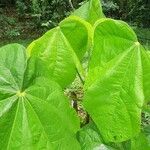Tree up to 30-40 m. high, the trunk straight, thick and often with prominently developed buttresses, the crown broad and dense. Leaves simple, large, the petiole 8-24 cm. long, stellate-villous, the blade deeply 3-to 5-palmatilobate, the broad lobes rounded to subacute, deeply cordate at the base, up to 22 cm. long and 40 cm. wide, membranous, the upper surface glabrous except near the base of the 5 main nerves, the lower surface stellate-arachnoid when young, promptly glabres-cent, the nerves slightly prominent beneath. Inflorescences axillary or subterminal, paniculate, the axes densely stellate-vi llous-arachnoid. Flowers hermaphrodite or staminate, the pedicel 1-2 cm. long; calyx campanulate, 5-lobate, 1.5-2 cm. long and 1.5-2.5 cm. wide, often somewhat larger in the hermaphrodite flowers than in the staminate ones, the lobes triangular, acute and ca. 0.7-1.2 cm. long, reddish-brown, densely puberulous and with tufted hairs outside, greenish-yellow, striped-red or maroon and glabrous inside; gonophore of the staminate flowers slender, arcuate, inflexed, ca. 1-1.2 cm. long, scatteringly papillate, sometimes loosely stellate-puberulous toward the base, the staminal tube pendulous, somewhat thicker than the gonophore, ca. 1 mm. long and densely covered with short simple hairs, the anthers 15, ca. 0.75 mm. long, the rudimentar ovary ca. 0.75 mm. broad and glabrous; gonophore of the hermaphrodite flowers like in the staminate ones but only 6-8 mm. long, the staminal tube very short, the anthers 15, around the base of the ovary and ca. 0.75 mm. long, the ovary subglobose, 5-sulcate, ca. 0.4 mm. in diam., stellate-tomentellous, 5-locular, the styles reflexed, ca. 4 mm. long and stellate-tomentellous, the stigma obscurely 5-lobulate. Follicles obovoid, ca. 6 cm. long and 4 cm. thick, tomentellous outside, the inner surface covered with a dense layer of erect, stiff, yellowish and ca. 2 mm. long prickly hairs, 2-to 4-seeded; seeds oblong-ellipsoid, ca. 2 cm. long and 1.1-1.3 cm. in diam., the testa brown or black, covered with stiff, little adhesive, prickly hairs.
More
A tree. It grows 15-30 m high. It spreads 9-15 m wide. It is like Sterculia chicha. The trunk is straight and has buttresses. The trunk can be 2 m across. It has an umbrella shaped crown. The leaf stalks are 20-25 cm long. The leaves are divided like fingers on a hand and are 30-35 cm long by 40-45 cm wide. The leaves are heart shaped and have 5 lobes. The lobes can be 15-50 cm long. The edges have irregular teeth. They are densely woolly when young. They are clustered near the ends of branches. The leaves hang down. The flowering stalk is 8-12 cm long. The flowers are 2-3 cm wide. The fruit are woody follicles and are narrow and dark brown. There are 3-4 capsules. These are 10-13 cm long by 8-12 cm wide. There are 7-10 seeds inside. The fruit contain 4-5 seeds. They are 2.5 cm long by 1.5 cm wide and black. These are oval. They are edible.





